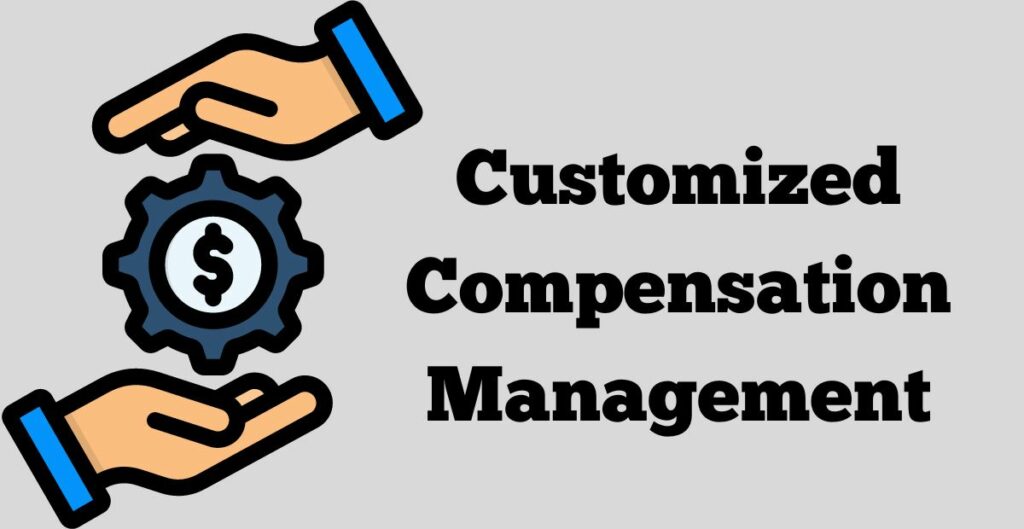Understanding Compensation Management
Humanizing Grasp of Compensation Management is like going through an intrepid expedition that comprises designing, implementing as well as managing the various forms of rewards and benefits that employees derive from the organization among others. It covers not only the base salaries but also the incentives, perks, and benefits; all of these serve as the real incentives for employees, and they contribute on a large scale to the processes of recruiting, motivating, and retaining them.
The recruiting processes in Human Resource Management (HRM) have a focal point amongst other processes in Compensation Management, which plays a crucial role in the achieving of organizational objectives as well as establishing a good working environment. At its core, Employee Engagement serves a multi-layered role, where it aligns with the recruiting activities to cull out top talent, enhances performance management systems to boost productivity, and employee engagement programs to boost loyalty and contentment.
Core Elements of Wages’ Strategies are the implementation of the overall set of principles, that, on the one hand, are based on the mission, values, and culture of the particular enterprise, and on the other hand – address a diversity of labor force. The starting point, then, is the competitiveness in awarding fair salaries to every employee and for the organization to stay attractive and competitive among its peers. In addition, a wide range of benefits packages consisting of healthcare, and retirement plans, among other amenities build the workers’ welfare and grow their loyalty to the enterprise.
At the same time, performance-based incentives such as bonuses and profit-sharing not only motivate employees to excel but also align their efforts with the company’s objectives, fostering a culture of accountability and success. Maintaining internal equity while ensuring external competitiveness is equally essential—businesses must distribute salaries fairly among employees while remaining attractive to top talent.
Transparency and clear communication of what rules and decisions are regarding remuneration policy and decisions are very important elements in making the employees trust you and feel that it is fair to them. In summary, outstanding compensation management strategies are flexible and responsive, developing and formulating to cater to the evolving needs of the organization more so to its workers.
Leveraging HRMS for Compensation Management
In today’s buzzing context of the human resource management field, companies are no longer content with “business as usual” but are constantly embracing new means that would shorten the way to achieving efficiency. While serving as the driver of this digital revolution is the Human Resource Management System (HRMS), a complete digital platform revamping the conventional systems of how companies deal with human resources. Let’s explore the significance of HRMS in the realm of compensation management:
Introduction to HRMS
HRMS (Human Resource Management System): HRMS is the central, and sophisticated, digital ecosystem that can automate and centralize numerous operations of the HR department. In that way, the HRMS stands alone as the backbone of the HR operations of modern-day organizations.
Key Features: Be it from hiring and posting to job analysis and training, HRMS exhibits a range of functionalities that improve efficiency, accuracy, and proper decision-making.
Benefits of Integrating Compensation Management into HRMS
As organizations grapple with the complexities of compensation management, integrating this critical function into the HRMS framework offers a multitude of benefits:
- Centralization of Data: HRMS will allow the companies to consolidate the information about employee compensation, which includes salaries, bonuses, allowances, and different types of health and insurance benefits. Here is the place of the advent of centralized storage. It points up accuracy, deletes duplicates, and helps to make wise decisions.
- Streamlined Processes: HRMS automates the whole paying management process which includes building the budget, allocating money, approving compensation, as well as issuing such. The automation procedures and notifications that do not require managers` involvement, are precise and speed up the processing of employee salaries, which certainly improves operational efficiency.
- Enhanced Transparency and Equity: By using HRMS, companies can automate their compensation management man processes by creating an equal and fair system where the salary is standardized, the rewards and incentives are performed clearly, and employees are treated according to company standards and external regulations. This creates an atmosphere of integrity, honesty, and fulfilment among the employees.
Features of Advanced Payroll Software
In the age of digitization, payroll software has increasingly been used not only for simple multiplication but also for the integration of complex platforms that possess a wide range of options. Let’s delve into the key features that characterize advanced payroll software:
- Automated Calculation: The software with the highest level of sophistication in payroll does the calculation of pay and takes off deductions and taxes based on requirements that it has accumulated from the set parameters. This avoids human error, guarantees precision, and makes payroll processing smoother.
- Employee Self-Service: Those platforms are generally equipped with self-help portals where employees can get their pay slips and other payroll details. The portal thereby autonomizes employees to manage data about their payroll which entails removing administrative workload and enriching employees.
- Direct Deposit and Payment Options: Development on the higher level of payroll software allows employees to receive their payments directly to their bank accounts which enables them not to use paper checks anymore and to hand out the salaries in a manual way. Furthermore, extending its payment methods to other forms of compensation management like prepaid cards or mobile wallets can help in achieving inclusivity.
- Integration with HR and Accounting Systems: High-processing software works well with other Human Resources and accounting systems; data can be exported or imported into them consequently. Thus, the duplicated data work is avoided. The process of combining this technology into one function results in better accuracy of data, more efficient operation, and a vantage point on organizational budgets.
- Customizable Reporting: These platforms have powerful reporting functionality, where businesses can transition from general to customized reports on payroll costs, staff members’ earnings, taxes, and other financial concerns. The sophisticated analytics tools are of the utmost importance in payroll compensation management as they give in-depth information about payroll trends, labor cost, and budget planning to name a few, so that the decision-making process could be feasible.
Automating Payroll Processes for Efficiency
Automating payroll processes through advanced payroll software offers numerous benefits for organizations:
- Time Savings: Payroll automation helps to reduce repetitive tasks like data entry, calculation, and reporting, which in turn leaves more time for people with functions in HR or finance to think more of strategic issues.
- Accuracy and Error Reduction: The majority of human errors in traditional payroll processing are significantly reduced with automation which means that the payroll is perfectly accurate for salary calculation as well as tax deduction and compliance filings. This assists also in reducing the possibility of expensive errors and the penalty from regulatory agencies.
- Timeliness and Compliance: Fully automated payroll treatments allow the companies to keep up with scheduled deadlines and abide by the mentioned requirements permitting them to be without financial penalties for delayed payments. The tax laws and regulations are constantly changing. The postponement of payouts minimizes the tax compliance risks.
Optimizing Payroll Accuracy
Improving your compensation management can lead to a more streamlined and effective system. With real-time updates on contractor hours and project progress, you can ensure that compensation is accurately calculated based on actual work. Integrating a contractor scheduling app into your compensation management system can greatly improve effectiveness and precision.
Ensuring Compliance with Payroll Regulations
Advanced payroll software plays a crucial role in ensuring compliance with payroll regulations:
- Automated Tax Calculations: Payroll software performs the mathematical operations automatically that calculate federal, state, and local taxes using the current tax rates and regulations, and henceforth ensures the right tax withholdings and deductions.
- Tax Filing and Reporting: Such platforms automatically make and e-file tax forms (like given examples of W-2, 1099) directly with the tax authorities, thereby making compliance with tax reporting requirements so easy. In that aspect, they also create payroll reports and reconcile payroll files due to tax obligations.
- Regulatory Updates: The payroll software in advance touches with the changes in tax laws, labour laws, and compliance requirements including the necessary updates as the updates call for. This means tax payroll processing rules will be in line with the changing regulatory landscape.
Designing Customized Compensation Management Packages
Understanding Employee Needs and Preferences
- Employee Surveys and Feedback: Organizations can draw data from surveys, focus groups, and personal interactions, which will provide an understanding of employee preferences, enhance collaboration, and create a positive working environment. Knowing factors of hobbies, lifestyles, finances, and career objectives is what gives companies an edge in providing executive compensation management packages that deal with the employees’ needs.
- Segmentation and Personalization: Through the process of employee grouping based on parameters, including job position, experience level, and performance, it is possible to customize rewards that are aligned with the workers’ varying needs in the different departments. Calling on the lines of personalized fringe benefits and rewards elevates employees’ satisfaction and engagement.
Flexibility and Choice
- Flexible Benefits Programs: Employees are encouraged to make the right decisions by providing them with a menu of benefits and compensation. Once they decide, they may choose offerings that are best suited to individual needs. Compensating the staff members with health care options, retirement plans or wellness allocations is another advantage of empowerment. It gives employees the leverage of totally interrogating and custom-making their compensation management packages.
- Customizable Compensation Management Structures: There are companies out there that can implement a flexible compensation management scheme, for example, cafeteria plans or total rewards package, under which the employees are empowered to decide how to distribute their salaries to meet their own goals. Such adaptability may match the existing employee’s choices of lifestyle and stage.
Financial and Non-Financial Incentives
- Holistic Reward Strategies for a Modern Workforce
While financial rewards such as salaries and bonuses remain important, today’s employees are equally driven by non-monetary motivators. Career growth pathways, continuous learning opportunities, meaningful recognition, flexible work options, and work-life balance initiatives all play a vital role in encouraging proactive performance. A well-rounded compensation strategy that blends monetary and experiential rewards not only boosts motivation but also strengthens loyalty among top talent.
- Strengthening Retention Through Long-Term Value Programs
More organizations are leveraging long-term incentive models—stock options, profit-sharing, and performance-based rewards—to deepen employee commitment. These programs give employees a tangible stake in the company’s future, reinforcing a sense of ownership and shared success. When individuals feel connected to organizational outcomes, their engagement, accountability, and long-term retention naturally increase.
Performance-Based Compensation Management Models
During the pursuit of a high-performance-oriented and performance-based culture and looking for organizational success, many companies are adopting the performance compensation management model. Let’s delve into the principles of performance-based compensation, strategies for implementing performance-based incentives, and how HRMS can facilitate the tracking of performance metrics:
Principles of Performance-Based Compensation Management Models
- Meritocracy: Merit-based compensation management systems, in which rewards are tied both to the performance of the individual and the overall achievement of the organization, stimulate a meritocratic culture in which only what is worth rewarding is subject to accolades.
- Alignment with Organizational Goals: Performance-based payment models reward employees through links to performance outcomes that align with organizational objectives, thereby, making employees focus on behaviours and actions that are favourable to business prosperity.
- Motivation and Engagement: Performance-based incentives are performance enhancers, therefore employees feel like they are responsible for their actions. Similarly, there is a high sense of engagement from employees. It will create an irresistible motive for the employees to try for best and excellence by making it clear to them what their performance expectations and rewards are.
Implementing Performance-Based Incentives
- Setting Clear Objectives and Metrics: It is recommended to set up performance objectives and KPIs that are in tune with strategic goals, containing organizational as well as individual business objectives. These indicators function as the basis for comparison and to assess either eligibility for rewards or performance assessment.
- Customized Incentive Plans: Targeting bonus schedules to areas of responsibility, up to the level of individuals and departments is an effective way of boosting their relevance and reducing their discriminatory nature. Incentives can range from cash bonuses, commissions, profit sharing, or stock options, depending on whether employees are expected to maximize sales, market penetration, or shareholder value.
- Regular Performance Reviews: Organizing periodic performance reviews and feedback conversations is where managers provide employees with timely feedback on the work done and point out performance shortfalls or development needs. Performance conversations also address the alignment of employee goals to the organizational values or goals for the year ahead.
Tracking Performance Metrics with HRMS
- Integration of Performance Compensation Management Module: HRMS systems tend to cover performance evaluation components that enable organizations to formulate, gather, and analyze performances instantly. The modules allow the procedure of the setting of performance targets, the review of working performance, and the gathering of a response from personnel.
- Automated Performance Evaluation: The HRMS takes care of the performance evaluation process, automating review setups and even performance ratings and their scheduling. Automated workflows guarantee adherence to standards and speed in the performance appraisal constancy.
- Real-Time Reporting and Analytics: With HRMS it becomes possible to create in real-time all kinds of reports and analytics giving the possibility to businesses to monitor performance metrics, spot trends and gain insights in terms of employees’ performance. The dashboards are custom-made. In this way, managers can analyze performance at different levels, either individual, team, or organizational.



